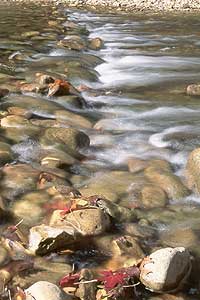
Water
Quality Assessment: Chemical: Hardness
 Stream
water hardness is the total concentration of cations, specifically calcium
(Ca2+), magnesium (Mg2+), iron (Fe2+),
and manganese (Mn2+), in the water. Water rich in these cations
is said to be "hard." Stream water hardness reflects the geology
of the catchment area. Sometimes it
also provides a measure of the influence of human activity in the area.
For instance, acid mine drainage often
results in the release of iron into a stream. The iron produces extraordinarily
high hardness readings. For these reasons, hardness is a useful water
quality indicator. Photo © 1999 -www.arttoday.com
Stream
water hardness is the total concentration of cations, specifically calcium
(Ca2+), magnesium (Mg2+), iron (Fe2+),
and manganese (Mn2+), in the water. Water rich in these cations
is said to be "hard." Stream water hardness reflects the geology
of the catchment area. Sometimes it
also provides a measure of the influence of human activity in the area.
For instance, acid mine drainage often
results in the release of iron into a stream. The iron produces extraordinarily
high hardness readings. For these reasons, hardness is a useful water
quality indicator. Photo © 1999 -www.arttoday.com
For the most part, however, hardness is a reflection of the amount of calcium and magnesium entering the stream through the weathering of rock such as limestone (CaCO3). When limestone is weathered, it dissolves into calcium (Ca2+) and carbonate (CO32-). Calcium is an important nutrient that is used by plants and animals. Carbonate buffers the stream's pH . Although these two ions are beneficial to a stream, they can cause problems in a home. Foaming agents such as those in soaps and detergents do not work as well in hard water. Also, hard water tends to leave hard, scaly calcium deposits on faucets. This is why many people install water softener systems in their homes.
Overview ..|.. Biological Assessment ..|.. Chemical Assessment ..|.. Physical Assessment.
pH
/ Alkalinity / Hardness / Nitrates.
Nitrites, and Ammonia / Ortho- and Total
Phosphate / Dissolved Oxygen and Biochemical
Oxygen Demand / Fecal Coliform / Conductivity
and Density
Glossary .|.
Related Links
.|..
References
..|..
PBL Model
.|
Home ..|.. Teacher Pages ..|.. Modules & Activities
HTML code by Chris Kreger
Maintained by ETE Team
Last updated November 10, 2004
Some images © 2004 www.clipart.com
Privacy Statement and Copyright © 1997-2004 by Wheeling Jesuit University/NASA-supported Classroom of the Future. All rights reserved.
Center for Educational Technologies, Circuit Board/Apple graphic logo, and COTF Classroom of the Future logo are registered trademarks of Wheeling Jesuit University.
